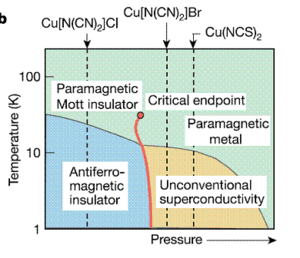Mott metal-insulator transition and magnetism: Difference between revisions
No edit summary |
No edit summary |
||
| (4 intermediate revisions by 3 users not shown) | |||
| Line 1: | Line 1: | ||
When we want to determine which material is a conductor, semiconductor or an insulator we turn to the Band Theory of Solids. This is done by plotting the energies of electrons which forms bands. In a conductor you have available electrons in the conduction band. With the insulators their is a gap between the conduction and the valence band. With semiconductor their is a small gap, small enough that if the electrons were excited to a certain energy they could actually leap the gap. Some materials do not follow the predictions of the Band Theory. Metal oxides, according to the Band theory were suppose to be conductors but actually turned out to be insulators. This is known as a Mott insulator. This is due to the fact that when each individual site is half full the electron electron repulsion is much larger than the hopping element. This makes the electrons immobile, declaring it an insulator. The Hubbard Model can explain this phenomena by introducing a new term when calculating the Hamiltonian. | |||
== | <math> H = -t \sum_{<i,j>,\sigma}( c^{\dagger}_{i,\sigma} c^{}_{j,\sigma}+ h.c.) + U \sum_{i=1}^{N} n_{i\uparrow} n_{i\downarrow} </math>, where <math> <i,j> </math> represents nearest-neighbor interaction on the lattice. | ||
This will give a new term U which will open a gap between the previous two bands. If t/U is too large then the two separate bands will merge. This will make the Mott insulator turn into a conductor. This t/U fraction will determine what is and what isn't a Mott insulator when considering materials such as metal oxides. | |||
[[Image:Mott.gif|300px|center]] | |||
Latest revision as of 14:20, 30 April 2011
When we want to determine which material is a conductor, semiconductor or an insulator we turn to the Band Theory of Solids. This is done by plotting the energies of electrons which forms bands. In a conductor you have available electrons in the conduction band. With the insulators their is a gap between the conduction and the valence band. With semiconductor their is a small gap, small enough that if the electrons were excited to a certain energy they could actually leap the gap. Some materials do not follow the predictions of the Band Theory. Metal oxides, according to the Band theory were suppose to be conductors but actually turned out to be insulators. This is known as a Mott insulator. This is due to the fact that when each individual site is half full the electron electron repulsion is much larger than the hopping element. This makes the electrons immobile, declaring it an insulator. The Hubbard Model can explain this phenomena by introducing a new term when calculating the Hamiltonian.
, where represents nearest-neighbor interaction on the lattice.
This will give a new term U which will open a gap between the previous two bands. If t/U is too large then the two separate bands will merge. This will make the Mott insulator turn into a conductor. This t/U fraction will determine what is and what isn't a Mott insulator when considering materials such as metal oxides.


